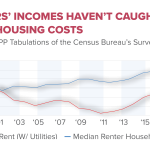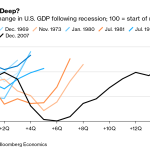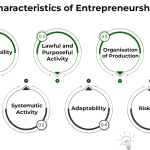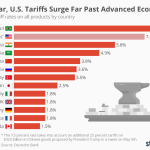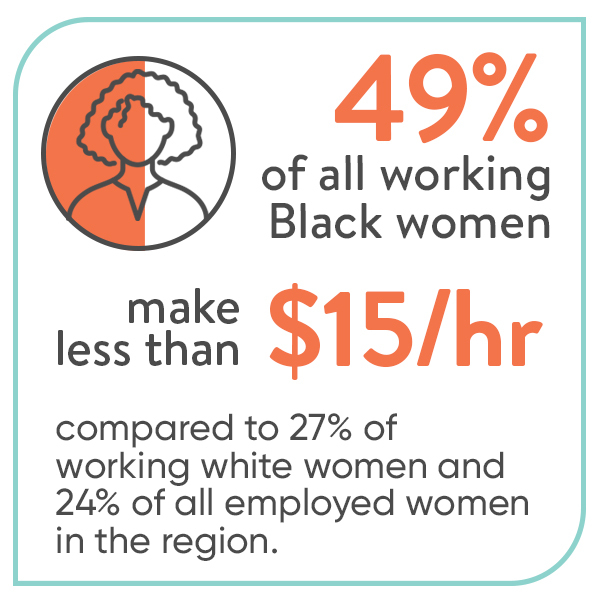Economic mobility for Black Americans has seen a notable shift in recent years, as highlighted by a groundbreaking study from Opportunity Insights. This research reveals that children of low-income Black Americans are experiencing improved economic prospects, contrasting sharply with the declining earnings of their low-income white counterparts. The analysis, which spans 40 years of tax and Census records, underscores a narrowing racial earnings gap while simultaneously exposing a growing disparity in economic outcomes based on class. By examining the dynamics of intergenerational mobility, the study sheds light on the unique challenges faced by low-income families and the evolving landscape of economic opportunity. Ultimately, these findings paint a complex picture of progress and persistent challenges for Black Americans striving for financial stability and upward mobility.
The recent advancements in financial ascendance for Black citizens born into low-income families signal a transformative period in the American socioeconomic landscape. Various studies, particularly from Opportunity Insights, emphasize the importance of understanding these shifts in economic potential amidst the broader context of racial dynamics and historical inequities. As we delve into the various factors influencing upward mobility, it becomes essential to address the persistent gaps in earnings between racial groups, especially when considering shifts in intergenerational wealth. These changes illustrate a unique intersection between race and class that shapes the realities for families across the nation. By exploring the potential for enhanced economic opportunities, we gain insight into the future prospects for Black Americans and the impact of supportive environments on achieving financial success.
Economic Mobility Improvements for Black Americans
The recent findings by Opportunity Insights indicate a remarkable shift in the economic mobility of Black Americans born into low-income families. This research highlights that the income of Black millennials, those born in 1992, has seen a significant improvement reaching an inflation-adjusted average of $21,030 at age 27. In contrast, their Black Gen X counterparts, born in 1978, only managed $19,420, illustrating a promising trend towards a better economic future for the younger generation. This increase has been attributed to various factors, including enhanced job opportunities, better access to education, and localized economic growth in regions previously burdened by high poverty rates.
Furthermore, the study outlines that not only have the earnings for low-income Black Americans improved, but they have also substantially narrowed the earnings gap with their white peers. The racial earnings disparity, although still persistent, declined from around $12,994 for Gen Xers to approximately $9,521 for millennials. This trend indicates that strategies aimed at increasing economic opportunities in Black communities are beginning to take effect, paving the way for further advancements in upward mobility.
The Opportunity Insights study reinforces the crucial role that childhood environments play in shaping the long-term economic prospects of individuals. For instance, it found that Black Americans born in certain regions, particularly in the Southeast and Midwest—areas historically characterized by high rates of Black poverty—have shown notable improvement in their economic outcomes. These shifts underscore the importance of localized community development initiatives that enhance job availability and educational resources, leading to greater economic mobility for disadvantaged groups.
Moreover, the data suggests that growing up in neighborhoods with higher parental employment rates can lead to more favorable economic results for children of all racial backgrounds, including low-income white families. The convergence of economic conditions reveals that better opportunities in one demographic can positively influence others, suggesting an interconnectedness within community growth. The shrinking gaps between Black and white economic outcomes provide a hopeful outlook for future generations.
The Role of Intergenerational Mobility in Economic Outcomes
Intergenerational mobility, or the ability for families to improve their economic situation across generations, is a key factor influencing the economic prospects of Black Americans. The Opportunity Insights research highlights that children born into low-income families have a better chance of moving out of poverty compared to previous generations. Specifically, the percentage of Black children born to families in the bottom income quintile who remain in poverty has decreased significantly, moving from 14.7% to just 4.1% for those born between 1978 and 1992. This change indicates a shift in opportunities available to families, reflecting broader societal changes that aim to promote economic equality.
As families experience upward mobility, it paves the way for new generations to build on their parents’ successes. Enhanced access to education and employment opportunities has opened doors that were previously closed to Black Americans, leading to a greater likelihood of achieving financial stability. With these improved prospects, families can invest more in their children’s education and health, creating a compounding effect on economic mobility. The findings underscore the importance of continued investment in communities focused on lifting up families from low-income backgrounds.
However, despite the progress made in reducing the earnings gap for millennials, challenges remain, particularly in addressing the widening class divide among different racial groups. The disparity between high-income and low-income white families has ballooned over the same period, revealing that while race gaps may be narrowing, the economic divides dictated by class are becoming more pronounced. This reality presents a pressing concern for policymakers and communities alike, who must address the dual challenges of racial and class-based economic disparities simultaneously.
To effectively tackle these issues, solutions must be multifaceted, focusing not only on boosting economic mobility for Black Americans but also on creating equitable opportunities for all low-income families. Programs aimed at job creation, education reform, and community investment are essential to ensure that the progress seen in Black economic mobility is not an isolated trend but rather part of a broader movement toward economic equality.
Racial Earnings Gap: Progress and Challenges Ahead
The racial earnings gap has long been a point of contention in discussions regarding economic mobility for Black Americans. The Opportunity Insights study reveals a positive trend in this regard—specifically that the earnings gap between Black and white Americans has narrowed significantly for millennials compared to Gen Xers. While the gap for the former group has fallen to $9,521 from $12,994 for their predecessors, it remains a substantial obstacle that requires ongoing attention and action to fully address.
This narrowing of the gap showcases the potential for progress; however, it also illustrates the need for sustained efforts to dismantle the systemic barriers that contribute to these disparities. A collaborative approach involving policymakers, community leaders, and advocacy organizations will be crucial to developing effective strategies aimed at further closing this earnings gap and enhancing economic mobility for Black Americans. The societal implications of such disparities extend beyond individual finances—they influence overall community health and stability.
Addressing the racial earnings gap requires understanding its roots in historical inequities, including access to quality education, employment opportunities, and social networks. Efforts to promote economic opportunities for Black Americans must focus on targeted investments in marginalized communities alongside educational reforms designed to equip children with the necessary skills to thrive in a competitive job market. By enhancing pathways to economic stability and collaboration—with an emphasis on restoring equity—societies can work toward reducing the existing racial earnings gap, thereby fostering an environment where all individuals, regardless of race, can achieve their economic potential.
Class Disparities and Their Economic Implications
The data from Opportunity Insights sheds light on a troubling trend—while economic mobility for low-income Black Americans has improved, the widening class gap among white families presents a significant challenge. The research shows that low-income white Americans have seen their earnings stagnate or decline, whereas high-income white families continue to flourish financially. This divergence illustrates the complexities of economic mobility, where racial equity gains do not uniformly benefit all low-income families.
The implications of growing class disparities extend far beyond individual economic outcomes; they affect societal cohesion and the overall health of communities. As the gap between the most affluent and the least affluent grows, social stability can be threatened, contributing to wider societal issues such as crime and poor health outcomes. Understanding and addressing class disparities is essential for a holistic approach to promoting long-term economic equity for all.
To combat these class disparities, a comprehensive strategy needs to be implemented. This should include policies that not only support low-income families but also address the structural inequities faced by different communities. Initiatives such as improved access to education, healthcare, and job training can assist families in breaking the cycle of poverty, enhancing economic mobility across class lines.
Furthermore, collective action grounded in community empowerment can help bridge these gaps. Mobilizing community resources, fostering partnerships between organizations, and ensuring that economic recovery initiatives are inclusive will be vital to achieving both racial and economic equality. The challenge lies not only in uplifting marginalized groups but in creating an economy where every individual has the opportunity to thrive.
Opportunity Insights Study: Key Findings and Recommendations
The Opportunity Insights study represents a groundbreaking examination of economic mobility trends, particularly focusing on Black Americans born into low-income families. By analyzing data spanning four decades, the researchers provide vital insights into the evolving relationship between race and class in America. They emphasize that while there have been significant strides in reducing racial earnings gaps, the emergence of a pronounced class divide indicates that economic growth is not equally distributed across different socio-economic strata. Researchers recommend that policymakers prioritize targeted interventions to address both racial and class disparities in economic outcomes, ensuring that improvements in mobility do not leave behind the most vulnerable populations.
Among the study’s recommendations is the need for stronger community support systems that foster job creation and educational equity. Investment in low-income neighborhoods that have historically faced economic hardships can lead to better outcomes for future generations. By focusing resources on strengthening community ties and improving access to essential services, the impacts of poverty and inequality can be mitigated, resulting in a more equitable society overall.
To translate the findings of the Opportunity Insights study into tangible progress, collaboration is essential among various stakeholders, including government, private sector, and non-profit organizations. By working together to implement comprehensive strategies aimed at workforce development, educational access, and support for families, these stakeholders can help facilitate long-term economic mobility for all individuals, particularly those from disadvantaged backgrounds. The study’s conclusions underscore the urgency of collective action to create pathways for success that acknowledge and address the intersectional challenges of race and class. The ultimate goal should be a society where economic opportunities are not a privilege of the few, but a shared right truly accessible to everyone.
Neighborhoods as Catalysts for Economic Mobility
The Opportunity Insights study emphasizes the critical role of neighborhoods as pivotal factors influencing economic mobility, especially for Black Americans and low-income families. It highlights how growing up in areas with high rates of parental employment contributes significantly to better economic outcomes for children. Regions that foster strong economic growth and provide access to quality education and jobs are essential for facilitating upward mobility. By understanding the socio-economic landscape of neighborhoods, interventions can be better designed to tap into their potential as catalysts for change and economic development.
Additionally, the encouragement of mixed-income communities can combat the isolation often experienced by low-income families, promoting social capital and enhancing local opportunities for all residents. Strategies aimed at revitalizing neighborhoods through investments in infrastructure, community resources, and job training programs can significantly change the trajectory of economic futures for the children raised in these environments.
However, enhancing the economic mobility of families living in struggling neighborhoods requires more than basic investment—it necessitates a holistic approach that addresses multiple facets of community well-being. This includes initiatives that promote health access, educational advancement, and social cohesion alongside economic support. By strengthening the overall fabric of a neighborhood, policymakers and community leaders can create a robust foundation for economic prosperity that uplifts all families, regardless of their background. The Opportunity Insights study serves as a reminder that targeted community efforts can yield significant dividends in breaking cycles of poverty and promoting equality in economic opportunities.
Racial and Class Dynamics in Economic Recovery
The intersection of racial and class dynamics represents a significant concern in discussions about economic recovery post-pandemic. The Opportunity Insights study draws attention to how the economic fortunes of low-income Black Americans have improved, even as many low-income whites have experienced stagnation or decline. This dual reality reflects broader societal shifts that require thoughtful analysis and intervention. The ongoing disparities indicate that economic policies must be carefully crafted to support recovery efforts that do not inadvertently widen existing gaps.
Addressing these dynamics involves understanding that recovery must not only focus on immediate economic indicators but also consider the social implications of widening class divides. It’s crucial to develop inclusive economic policies that empower marginalized communities while revitalizing struggling local economies. Collaborative efforts among community organizations and government can create frameworks that ensure recovery strategies are equitable and address the unique challenges faced by different groups.
Moreover, as the economy evolves, policymakers must prioritize workforce development programs aimed at equipping individuals from low-income families with the necessary skills to adapt to jobs in emerging sectors. Investing in education and training tailored to the needs of disadvantaged communities can help break the cycle of poverty and create a more equitable landscape for economic mobility. The findings from Opportunity Insights underscore the need for a comprehensive approach to economic recovery—one that simultaneously addresses racial and class disparities to foster an inclusive environment for all.
Strategies to Promote Economic Mobility
To effectively promote economic mobility, particularly for low-income Black Americans, a multi-faceted approach is essential. The Opportunity Insights study suggests that enhancing access to quality education, job training, and community resources is vital in creating a pathway out of poverty. Furthermore, there must be a concerted effort to ensure that economic opportunities are not limited to certain demographics but are genuinely accessible to all individuals, regardless of background. Programs that provide scholarships, mentorship, and career counseling can empower young people from low-income families, giving them the tools needed to succeed in today’s competitive job market.
Additionally, strengthening partnerships between local governments, nonprofits, and private sectors can yield substantial advantages for communities aiming to uplift their economically disadvantaged members. By pooling resources and expertise, these collaborative efforts can address systemic challenges head-on—creating a supportive environment where families can thrive economically. The convergence of such initiatives has the potential to create sustainable improvements in economic mobility across generations.
Alongside education and employment initiatives, addressing the structural barriers that perpetuate inequality is crucial for effective economic mobility strategies. Policymakers must be diligent in enacting legislation aimed at reducing discrimination in hiring practices and ensuring that marginalized communities have equitable access to essential services. Integrating equity-focused approaches into economic development plans can help dismantle the root causes of poverty and inequality. As demonstrated by the Opportunity Insights findings, when communities invest in empowering their residents, they foster an environment where sustained economic growth and mobility can flourish, benefiting all, irrespective of race or class.
Frequently Asked Questions
What recent studies reveal about economic mobility for Black Americans?
Recent research, particularly from Opportunity Insights, shows that economic mobility for Black Americans, especially those born into low-income families, has improved. The study indicates that Black millennials born in 1992 earn an average of $21,030 by age 27, up from $19,420 for Black Gen Xers born in 1978, reflecting a positive trend in Black Americans’ economic prospects.
How has the racial earnings gap affected economic mobility for Black Americans?
The racial earnings gap, while still significant, has narrowed for Black Americans over recent years. Research notes that the gap for those born in 1992 fell to $9,521 from $12,994 for those born in 1978, indicating progress in intergenerational mobility among Black Americans.
What factors contribute to intergenerational mobility for Black Americans?
Intergenerational mobility for Black Americans is influenced by various factors, including neighborhood environments and parental employment rates. Studies show that growing up in areas with strong parental employment significantly boosts early adulthood earnings, highlighting the importance of community resources in improving economic prospects for Black Americans.
What impact does economic mobility have on low-income families of Black Americans?
Economic mobility has a profound impact on low-income families of Black Americans by providing better future earnings potential. With improved average incomes for Black millennials, there is a greater chance of moving out of poverty compared to previous generations, fostering hope and opportunities for low-income families.
How do changes in community environments affect economic opportunities for Black Americans?
Research indicates that changing community environments can rapidly influence economic opportunities. Areas with increased employment rates among parents have shown better outcomes for Black children, demonstrating that thriving communities are critical for enhancing economic mobility for Black Americans.
What are the findings of the Opportunity Insights study regarding Black Americans’ economic prospects?
The Opportunity Insights study reveals that Black Americans born into low-income situations have seen improved economic prospects in recent years, with enhancements in their early adulthood earnings and a decrease in the likelihood of remaining in poverty compared to past generations.
How does economic mobility for Black Americans compare to that of white Americans?
While economic mobility for Black Americans has seen improvements, disparities still exist when compared to white Americans. For millennials, the earnings gap has narrowed, but low-income white families have also shown a widening wealth gap, suggesting that economic mobility trends vary significantly by race and socioeconomic class.
What are the implications of the widening class gap observed in economic mobility studies?
The widening class gap indicates that while Black Americans experience shrinking race gaps in economic mobility, socio-economic disparities continue to grow among different classes, particularly affecting low-income white families. This highlights the complexity of economic health across racial and economic lines.
| Key Findings | Details |
|---|---|
| Economic Mobility for Black Americans | Black Americans born poor have seen improved economic prospects compared to previous generations. |
| Income Comparison | Black millennials average $21,030 at age 27, compared to $19,420 for Black Gen Xers. |
| Racial Earnings Gap | Racial gap for Gen Xers: $12,994; for millennials: reduced to $9,521. |
| Regional Variations | Significant improvements noted in the Southeast and Midwest for Black Americans. |
| Impact of Community | Higher neighborhood employment rates correlate with better outcomes for all children. |
| Growing Class Gaps | Widening income disparity among white Americans as poorer whites earn less over time. |
Summary
Economic mobility for Black Americans has shown promising improvements in recent years, indicating a significant shift toward better opportunities for those born into lower-income families. Research signals a narrowing of the economic divide between low-income Black Americans and their white counterparts, while highlighting persistent challenges that remain within class disparities. Understanding these dynamics is crucial for fostering inclusive economic policies that support continued upward movement for Black Americans and address the broader socio-economic gaps.
